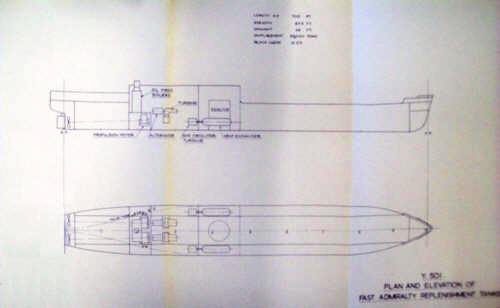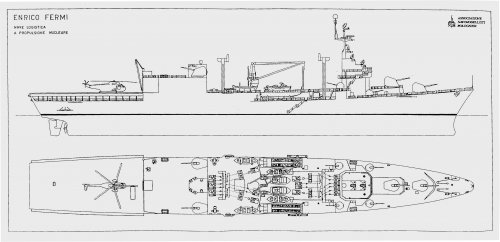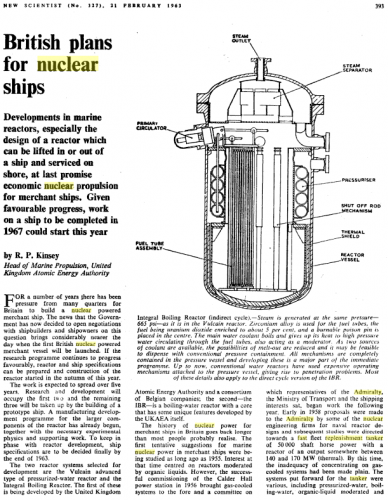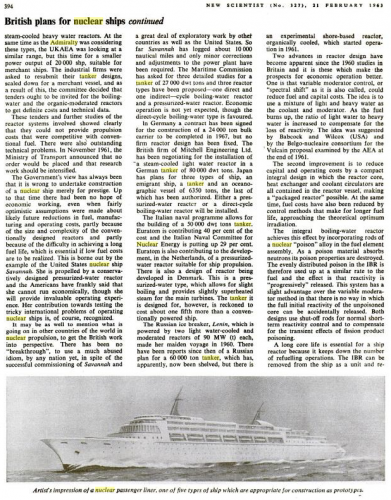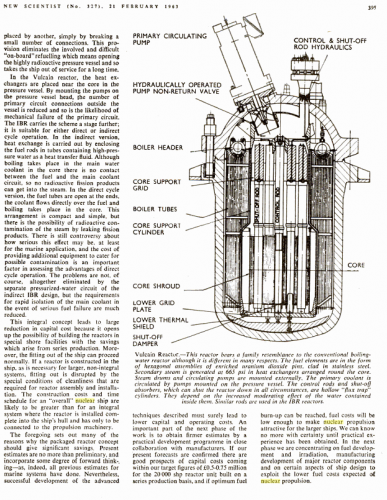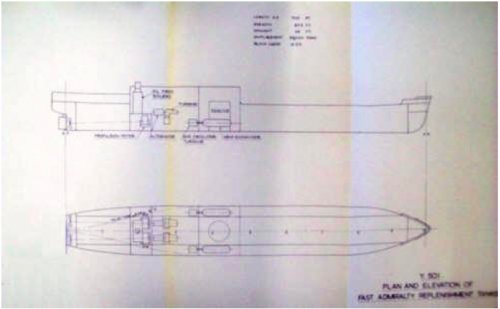Found this (part) article from another posting which may help....
In 1960, the Ministry of Transport requested proposals for nuclear propulsion solutions for a 65,000 dwt freighting tanker (hull designation YJ127) with around 20,000 shp in a single-shaft arrangement. The hull was eventually defined as having a length of 775 feet, a beam of 112 feet 6 inches, and a maximum loaded draft of 43 feet 6 inches. Speed was 15.5 knots. The reactor was to be either a Boiling Water Indirect Cycle or Organic Liquid Moderated design.
As this project was progressing, the designers were told to study putting a version of the same reactor into a naval replenishment vessel, designated the Fast Admiralty Replenishment Tanker (Y501) whil the commercial vessel became known as Y502. This would have been a 35,000 dwt vessel with two shafts. It appears that the intent was to use the one reactor to drive two turbines and to add a supplemental turbo-electric drive system to each shaft for 5,000 shp. (Presumably this was to provide get-home power in the event the reactor were disabled.)
In the early 1960’s whilst Cliff Richard was strutting his stuff, skirts were getting shorter and hair was getting longer the Ministry of Transport asked Yarrow’s Admiralty Research Department to seek tenders for the installation of a nuclear reactor power plant in a 65,000 ton deadweight commercial tanker hull with the designation Y127, the ship itself had not actually been designed and the tender was for the feasibility of designing, installing and after care of the nuclear power plant.
In March and April of 1960 meetings were held between English Electric, Hawker Siddley, Babcox and Wilcox, Mitchell Engineering and the Nuclear Power Group to find the best way forward and to consider the requirements for the tender.
The ship was visualised as a commercial freighting tanker of 20,000 shaft horse power, with a single screw, and a reactor of either the Boiling Water Indirect Cycle or, the Organic Liquid Moderated Type. However the tender was not to include the perceived dockside and port facilities that would be required to maintain the nuclear power plant, like the re-fuelling of the reactor and the handling of the spent radioactive fuel, instead the costing’s for this were to be quoted separately.
The closing date for the tender was to have been the 29th July 1960 and a number of meetings of the various firms involved took place prior to this date. The firms involved each brought their own particular expertise to the project, with the Nuclear Power Group (Swan Hunter’s) looking at the design of the stainless steel clad pressure vessel and the primary shielding as well as the proposed design of the ships structure to support the containment facility, English Electric the containment structure, reactor layout and the steam generator plant.
After the initial meetings one problem surfaced that needed to be urgently addressed, so Yarrows asked the Nuclear Power Group for guidance on the rate of sinking of the ship in case of accident, so that they could ensure the containment structure was pressure balanced by flooding at submergence below 100 feet, supposing that the ship was sinking at around 1 foot per second, this raised the question of the valves required to equalize the pressure in the reactor and it was found that further work needed to be carried out to overcome the problem.
Another problem that was to be overcome by the designers of the nuclear power plant and machinery spaces, was the fact that the tender for the hull itself had not actually been called for, so any installation problems would have to be studied without any detailed design or construction plans so it was suggested that the designers needed to enlist the help of both a shipbuilder and a marine engineer.
When the specifications for the ship were put down on paper the length of the tanker was envisaged as 775 feet with a beam of 112 feet 6 inches and a maximum loaded draught of 43 feet 6 inches, and a fully loaded speed of 15.5 knots. The designers also had to look at the possibility of using a commercial hull already building, or in the design stage to the specifications stated, but with modifications to the machinery spaces to accommodate the nuclear plant. This would mean the removal of the boilers and auxiliary machinery, bunkers removed from the engine room tanks and the deep tank forward. The nuclear plant would then have been installed in its own compartment, separated from the ships side by special collision protection; it was then found that the cargo would have to be re-distributed to maintain strength and trim.
The reactor room would then have been placed immediately forward of the engine room, but separated from it by an oil-tight bulkhead and the sides of the reactor room would have been formed by a continuation of the cargo tanks longitudinal bulkheads, with the wing tanks outboard of the bulkheads designed as collision protection.
Just to complicate matter further the group looking at the tender for the nuclear power plant then received instruction to consider the installation of the power plant in a 35,000 ton deadweight Fast Admiralty Replenishment Tanker, which was given the designation Y501, whilst the commercial tanker became Y502.
The Admiralty Replenishment Tanker would in addition to the nuclear power plant, have a turbo-electric drive producing 5,000 shaft horse power and with the nuclear output this would have been 30,000 shaft horse power on each of the two shafts. The design would also have included cargo pumps capable of giving 800 tons per hour when used for replenishment at sea, which would I am sure been very interesting when RASing. The whole of the nuclear powered tanker design programme was finally abandoned in November 1961as not being cost effective or practical,

